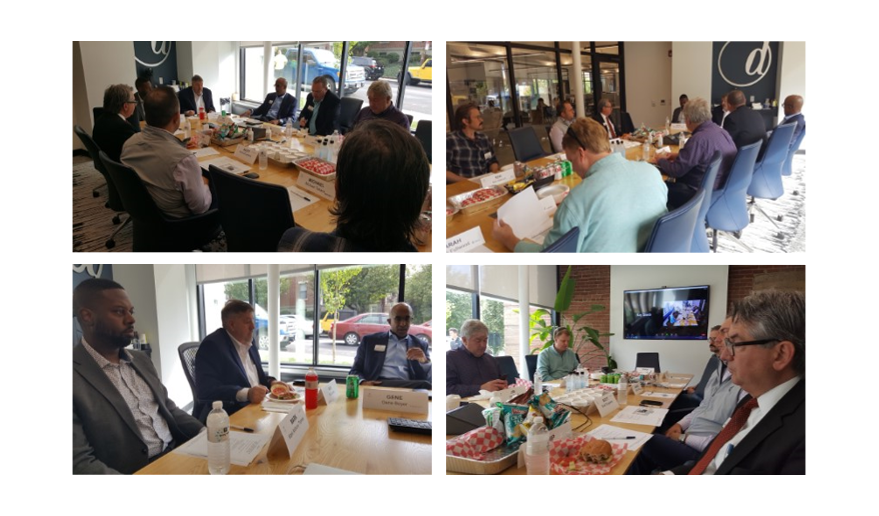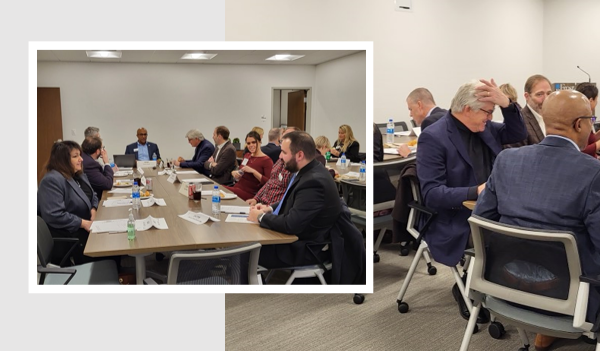Pittsburgh October 2021 – Key Take-Aways
- Speaker Mark Anthony Thomas, Pittsburgh Regional Alliance executive director and real estate professional, came here 2 ½ years ago, by way of Atlanta and New York City. His first order of business is how to position the region to grow: What industries will create jobs? Where is our growth, and how do we reconfigure our message to go after that growth?
- Thomas is hiring at PRA, both folks to conduct research and some to market the region and predicts more of the staff will be involved in artificial intelligence and other matters that “we didn’t know we should be part of.”
- The old adage “Attract business and that will attract people” might have been the solution in 2008 but it doesn’t work as well today. Now, PRA is marketing to people who want to live in a “great place.”
- R.K. Mellon Foundation provided a small grant to study what it’ll take to attract workers and keep the 40,000 students who are leaving Pittsburgh after they graduate.
- Diversity remains a problem that’s hard to tackle. If Ed Gainey is elected mayor, as expected, having him as the face of Pittsburg could help with that somewhat.
- Pittsburghers sometimes lack a belief in their own city. Recruiters need a more modern approach, and it’ll be a long-term push, not one with immediate results.
- Pittsburgh needs infrastructure to help companies commercialize and hire the talent they need, such as management training programs to help people become familiar with certain industries.
- Even with all its life sciences and biotech development at universities, Pittsburgh didn’t even register on the list of areas with available biotech lab space for companies. “We were too small here,” Thomas says. Sometimes PRA hears that Pittsburgh was being considered for a company’s relocation, but no one contacted the organization.
- The university community is a piece of the pie, but not the whole pie, when it comes to startups and spinoffs.
- Philadelphia is a more established market, with its University City (home to Penn and Drexel). They’ve got 3 million square feet of space to offer and are on a path to continue to dominate.
- Pittsburgh’s universities are solving all types of problems to help power the region, and that’s promising; the city is nowhere near reaching its potential. We need to manage expectations, though; it won’t happen within two years. Universities and hospitals here have decided they want to be in the real estate business.
- The state and/or local economic development corporations need to help fund people with ideas. Other cities provide incentives and guarantees to share the risk.
- The next big need? PRA has hired a startup czar, to support keeping entrepreneurial talent in the region. PRA is also encouraging reuse of empty office buildings. Part of what’s necessary is helping decision-makers to rethink what Downtown should be.
- Chip Desmone: Recently got approval for 300 units in Cleveland, in a warehouse next to the ballpark. Just got the go-ahead to do 270 units, plus 30 townhouses, on McKnight Road. Have put in a proposal to convert a Downtown office building to apartments. A lot of Desmone’s office business is expansions, some renovations — only one client is downsizing. Desmone has three flex space projects in warehouse/industrial spaces; these would add up to about 700,000 or 800,000 square feet. Since this is just one architectural firm, it demonstrates the activity that’s out there. Desmone has lots of optimism about 2022.
- AJ Pantoni: Busiest year ever. Recently connected a property he held in West Virginia for seven years with a company out of Turkey that has waived due diligence and announced they’re coming. The industrial market is “off the charts.” If someone doesn’t want to do a deal, no problem — someone else will. The market remains strong; just need to get through the pandemic. People are starting to see market impact from the supply chain disruption, but there are folks wanting to develop. Still, he worries that downtown has a rocky immediate future ahead of it, because companies and employees aren’t returning to work quickly.
- Ray Steeb: Providing maintenance support for existing buildings. We see a lot of activity; the only thing people still not doing is trying new things to run more efficiently. I find that amazing, especially with the continuing shrinkage of the labor pool. As we keep talking to customers and potential customers, we’ll let you guys know. Existing customers are expanding but securing new ones is a high hurdle; people are not willing to take that chance yet.
- Gene Boyer: New with Burns Scalo Real Estate. Commitment to new and innovating Class A real estate – i.e., The Vision on 15th in Strip District. Was brought on board to identify and grow opportunities to third-party clients.
- Scott DiGuglielmo: Burns Scalo’s director of brokerage. The firm is looking to get into industrial, multifamily, and some retail. Looking into national options, outside of Pittsburgh, a well. Burns Scalo is in “total growth mode right now,” and foresees “a good future.” On the leasing end, companies want to be in new real estate and they’re paying for it: Deals north of $40 per square foot. Life science deals are north of $60, $70 or $80 per square foot. Some companies are willing to take slightly less space, or the same amount, and are willing to pay for the newer, better space.
- Jim Futrell: Has a special topic briefing next week that will include census results and the region’s demographics. But the census is limited in what it offers, in terms of robust data; we rely on other products from the Census Bureau to get a deeper understanding of what’s happening. There are good signs: It’s the first census since 1970 that shows an increase in population for the region, albeit a small one. Too premature to declare victory. The region is becoming more diverse but still has a long way to go. Allegheny County numbers roughly equal the states, but the rest of the region is far behind. The region is aging more slowly than the country as a whole; that’s also good news. Median age in the city is where it was in 1980, and Allegheny County is getting younger. There are also a couple of concerning things: Early in the decade, the economy was doing well and experienced growth, but how much of that is limited to the 2010-13 period? There’s a strong correlation in this region to the national unemployment rate — the higher the national rate, the lower here and we gain people. Seven of the 10 counties lost people – significant numbers. What we see around us has not yet manifested in Greene, Fayette, Armstrong counties. Age 25-34 sector is growing slightly faster, but there’s weakness in the 35-54 age group. Birth rate hit a record low in 2020, so natural population decrease continues. A bright spot was immigration, but that dried up because of COVID. One reason that’s important: immigrants tend to be younger and have more children.
- Ben Atwood: Third month in Pittsburgh. Has been walking around Downtown. Started to think maybe a migration toward Grant Street is coming. Recently got authorization to do video news stories, which opens the door for some interviews.
- Jamey Noland: Bigger naysayer on Downtown than most. Fringe is hot right now; the trend started before COVID and continues. Lots of people want multifamily redevelopment of office buildings, but is there demand for 6,000 apartments? Brokers say there is an influx of people coming into the city, though not Downtown; East Liberty, the Strip are still hot. Starting to see pushback on pricing. With construction prices rising, people are questioning the price of, say, a one-bedroom apartment in East Liberty. And pushback on pricing makes projects more difficult to finance and get off the ground. In Cleveland, bursting at the seams – mostly because of subsidies/support from the city. Pittsburgh does not get anywhere near what Cleveland does to build out the multifamily and industrial markets. Lots of trepidation in the market about inclusionary zoning that may take place in spring; this would be a blanket overlay of Downtown areas to mandate affordability for multifamily projects. Bigger money from investors that was coming in is starting to dry up. At a precipice: Pricing will make this go one way, or the other. With pandemic, employees seem to be driving the market right now, not employers.






Recent Comments